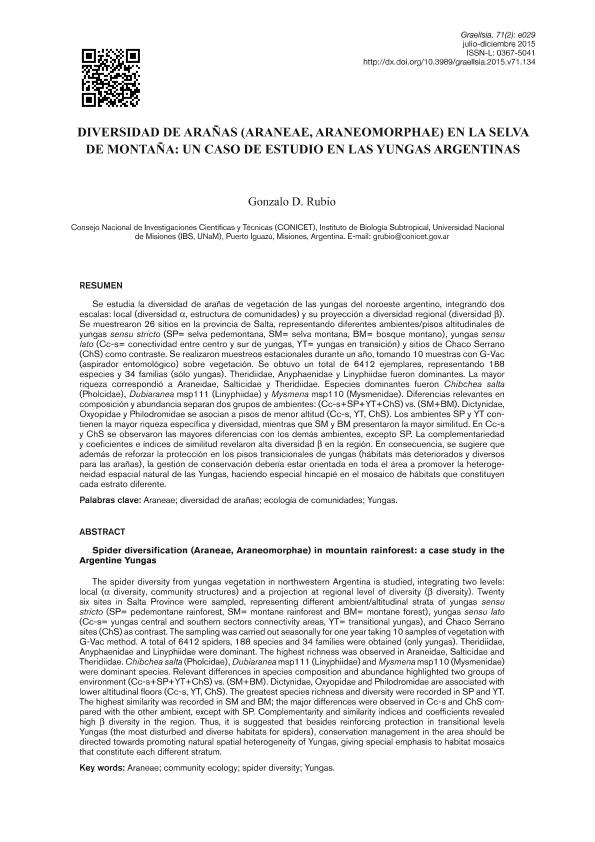Artículo
Se estudia la diversidad de arañas de vegetación de las yungas del noroeste argentino, integrando dos escalas: local (diversidad α, estructura de comunidades) y su proyección a diversidad regional (diversidad β). Se muestrearon 26 sitios en la provincia de Salta, representando diferentes ambientes/pisos altitudinales de yungas sensu stricto (SP= selva pedemontana, SM= selva montana, BM= bosque montano), yungas sensu lato (Cc-s= conectividad entre centro y sur de yungas, YT= yungas en transición) y sitios de Chaco Serrano (ChS) como contraste. Se realizaron muestreos estacionales durante un año, tomando 10 muestras con G-Vac (aspirador entomológico) sobre vegetación. Se obtuvo un total de 6412 ejemplares, representando 188 especies y 34 familias (sólo yungas). Theridiidae, Anyphaenidae y Linyphiidae fueron dominantes. La mayor riqueza correspondió a Araneidae, Salticidae y Theridiidae. Especies dominantes fueron Chibchea salta (Pholcidae), Dubiaranea msp111 (Linyphiidae) y Mysmena msp110 (Mysmenidae). Diferencias relevantes en composición y abundancia separan dos grupos de ambientes: (Cc-s+SP+YT+ChS) vs. (SM+BM). Dictynidae, Oxyopidae y Philodromidae se asocian a pisos de menor altitud (Cc-s, YT, ChS). Los ambientes SP y YT contienen la mayor riqueza específica y diversidad, mientras que SM y BM presentaron la mayor similitud. En Cc-s y ChS se observaron las mayores diferencias con los demás ambientes, excepto SP. La complementariedad y coeficientes e índices de similitud revelaron alta diversidad β en la región. En consecuencia, se sugiere que además de reforzar la protección en los pisos transicionales de yungas (hábitats más deteriorados y diversos para las arañas), la gestión de conservación debería estar orientada en toda el área a promover la heterogeneidad espacial natural de las Yungas, haciendo especial hincapié en el mosaico de hábitats que constituyen cada estrato diferente. The spider diversity from yungas vegetation in northwestern Argentina is studied, integrating two levels: local (α diversity, community structures) and a projection at regional level of diversity (β diversity). Twenty six sites in Salta Province were sampled, representing different ambient/altitudinal strata of yungas sensu stricto (SP= pedemontane rainforest, SM= montane rainforest and BM= montane forest), yungas sensu lato (Cc-s= yungas central and southern sectors connectivity areas, YT= transitional yungas), and Chaco Serrano sites (ChS) as contrast. The sampling was carried out seasonally for one year taking 10 samples of vegetation with G-Vac method. A total of 6412 spiders, 188 species and 34 families were obtained (only yungas). Theridiidae, Anyphaenidae and Linyphiidae were dominant. The highest richness was observed in Araneidae, Salticidae and Theridiidae. Chibchea salta (Pholcidae), Dubiaranea msp111 (Linyphiidae) and Mysmena msp110 (Mysmenidae) were dominant species. Relevant differences in species composition and abundance highlighted two groups of environment (Cc-s+SP+YT+ChS) vs. (SM+BM). Dictynidae, Oxyopidae and Philodromidae are associated with lower altitudinal floors (Cc-s, YT, ChS). The greatest species richness and diversity were recorded in SP and YT. The highest similarity was recorded in SM and BM; the major differences were observed in Cc-s and ChS compared with the other ambient, except with SP. Complementarity and similarity indices and coefficients revealed high β diversity in the region. Thus, it is suggested that besides reinforcing protection in transitional levels Yungas (the most disturbed and diverse habitats for spiders), conservation management in the area should be directed towards promoting natural spatial heterogeneity of Yungas, giving special emphasis to habitat mosaics that constitute each different stratum.
Diversidad de arañas (Araneae, Araneomorphae) en la selva de montaña: un caso de estudio en las Yungas Argentinas
Fecha de publicación:
08/2015
Editorial:
Museo Nacional de Ciencias Naturales
Revista:
Graellsia
ISSN:
0367-5041
e-ISSN:
1989-953x
Idioma:
Español
Tipo de recurso:
Artículo publicado
Clasificación temática:
Resumen
Archivos asociados
Licencia
Identificadores
Colecciones
Articulos(CCT - NORDESTE)
Articulos de CTRO.CIENTIFICO TECNOL.CONICET - NORDESTE
Articulos de CTRO.CIENTIFICO TECNOL.CONICET - NORDESTE
Citación
Rubio, Gonzalo Daniel; Diversidad de arañas (Araneae, Araneomorphae) en la selva de montaña: un caso de estudio en las Yungas Argentinas; Museo Nacional de Ciencias Naturales; Graellsia; 71; 2; 8-2015; 1-21
Compartir
Altmétricas




